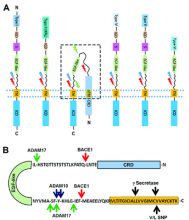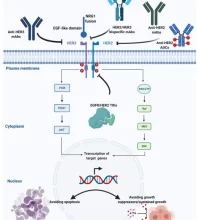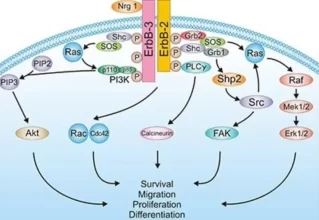Nexedes Products
Aging Research Medicine Products
Nexedes NRG7
The Neuregulin NRG cytokine family comprises four genes that encode a large number of secreted or membrane-bound isoforms.
All family members share an EGF-like domain that interacts with the ErbB family of tyrosine kinase receptors.
The NRG gene is the most pleiotropic, encoding more than 14 soluble or transmembrane proteins.
The NRG isoforms can be classified into Type I (neu differentiation factor, NDF; heregulin, HRG; acetylcholine receptor inducing activity, ARIA),
Type II (glial growth factor, GGF) and Type III (sensory and motor neuron-derived factor, SMDF) isoforms.
The NRG proteins show distinct spatial and temporal expression patterns and play important roles during development of both the nervous system and the heart.
Nexedes Sirt6
Enzyme SIRT6 is a chromatin-associated protein that is required for normal base excision repair and double-strand break repair of DNA damage in mammalian cells.
Deficiency of SIRT6 leads to abnormalities that overlap with aging-associated degenerative processes.
Enzyme SIRT6 promotes the repair of DNA double-strand breaks by the process of non-homologous end joining and homologous recombination.
Enzyme SIRT6 stabilizes the repair protein DNA-PK (DNA-dependent protein kinase catalytic subunit) at chromatin sites of damage.
As normal human fibroblasts replicate and progress towards replicative senescence the capability to undergo homologous recombinational repair (HRR) declines.
However, over-expression of SIRT6 in “middle-aged” and pre-senescent cells strongly stimulates HRR.
This effect depends on the mono-ADP ribosylation activity of polymerase.
Enzyme SIRT6 also rescues the decline in base excision repair of aged human fibroblasts in a PARP1 dependent manner.
The enzymatic activity of Sirt6, as well as of the other members of the sirtuins family, is dependent upon the binding of the cofactor nicotinamide adenine dinucleotide.
The study showed that the longevity of the species was correlated with the efficiency of the SIRT6 enzyme.

DNA repair facilitates greater longevity
The lymphoblastoid cell lines established from blood samples of humans who lived past 100 years (centenarians) have significantly higher activity of the DNA repair protein Poly (ADP-ribose) polymerase (PARP) than cell lines from younger individuals (20 to 70 years old).
The lymphocytic cells of centenarians have characteristics typical of cells from young people, both in their capability of priming the mechanism of repair after H2O2 sublethal oxidative DNA damage and in their PARP capacity.
In estimates made for rodents, DNA lesions occur on average 25 to 115 times per minute in each cell, or about 36,000 to 160,000 per cell per day. Some DNA damage may remain in any cell despite the action of repair processes.
The accumulation of unrepaired DNA damage is more prevalent in certain types of cells, particularly in non-replicating or slowly replicating cells, such as cells in the brain, skeletal and cardiac muscle.



